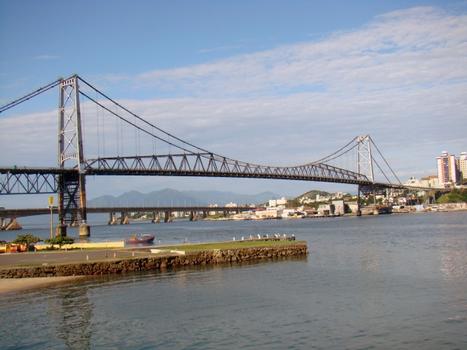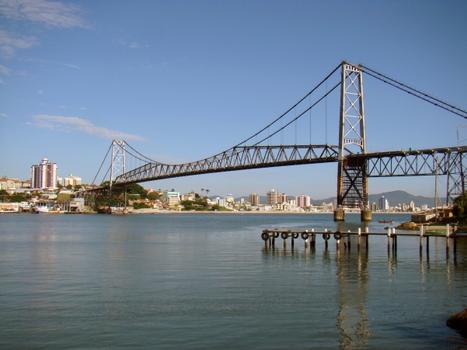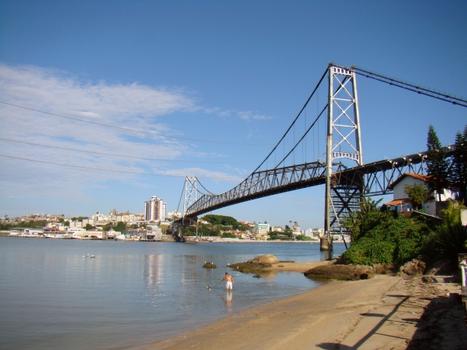General Information
| Name in local language: | Ponte Hercílio Luz |
|---|---|
| Beginning of works: | 14 November 1922 |
| Completion: | 13 May 1926 |
| Duration of works: | 3 years 4 months |
| Status: | in use |
Project Type
| Structure: |
Chain suspension bridge |
|---|---|
| Function / usage: |
Road bridge |
| Material: |
Steel bridge |
| Plan view: |
Structurae Plus/Pro - Subscribe Now! |
| Support conditions: |
for registered users |
| Secondary structure(s): |
Structurae Plus/Pro - Subscribe Now! |
| Material: |
Structurae Plus/Pro - Subscribe Now! |
Location
| Location: |
Florianopolis, Santa Catarina, Brazil |
|---|---|
| Coordinates: | 27° 35' 38.34" S 48° 33' 58.32" W |
Technical Information
Dimensions
| main span | 340 m | |
| total length | 819.5 m | |
| pylons | pylon height | 74 m |
Materials
| chains |
steel eye-bars
|
|---|---|
| pylons |
steel
|
| deck truss |
steel
|
Chronology
| 13 May 1991 | Closed to all traffic. |
|---|---|
| 30 December 2019 | After renovation, the bridge is re-opened to traffic. |
Excerpt from Wikipedia
Located in Florianopolis, the capital city of Santa Catarina State in southern Brazil, the Hercilio Luz Bridge is the first bridge constructed to link the Island of Santa Catarina to the mainland. It is the longest suspension bridge in Brazil. The central span was considered quite long (but not the longest, at 340 metres) at the time of its opening and is still one of the 100 largest suspension bridges.
Construction commenced on 14 November 1922 with the bridge being inaugurated on May 13, 1926. The total length is 819.471 metres, with 259 metres of viaduct from the island, a central span of 339.471 metres and 221 metres of viaduct from the mainland. The steel structure weighs approximately weight five thousand tons, and the foundations and pillars consumed 14.250m³ of concrete. The two towers rise 74 metres from sea level, and the central span is 43 metres tall.
It has been closed to the public since May 13, 1991.
Historical background
The bridge was commissioned by Hercílio Luz, then governor of the state of Santa Catarina, to be the first permanent link between the island and the mainland. In addition to benefiting the then 40,000 residents of Florianópolis that were dependent on ferries to cross between the island and the mainland, Luz wanted to build the bridge to strengthen the position of Florianópolis as the state capital. At the time, other cities in the state considered the island to be too remote to be the administrative and political centre and consequently there was a movement to transfer the capital to Lages.
Construction
The bridge was designed by the firm of Robinson & Steinman, and was built by the American Bridge Company (ABC). All the material it used was brought from the United States.
It has the fairly unusual feature that the truss carrying the roadway (a continuous stiffening component) is above the roadway itself and meets up with the eyebar chains making it non uniform in height. A similar bridge, the Walter Taylor Bridge, was built over the Brisbane River in Brisbane, Australia in 1936.
When completed the bridge was the longest eyebar suspension span in existence at that time. The 1,113’ long design features towers with rocker bearings. ABC brought to the project its own experimental heat-treated eyebars, and as project contractor pioneered stiffening techniques that saved materials and money while providing greater rigidity. Another bridge of similar design, the Silver Bridge over the Ohio River in the U.S., collapsed in 1967 due to a failure in one of the eyebars.
Luz didn't get to see his bridge completed, dying in 1924 twelve days after having inaugurated a wooden replica built in XV Square specifically for the symbolic act. Originally intended to be named the Independence Bridge this was changed after Luz's death in a posthumous tribute. The bridge was inaugurated on May 13, 1926.
Financing
From the beginning, the funding process was complicated. The first bank that had lent to the Catarina government failed. Thus, a new loan had to be obtained delaying the works. In addition, a manoeuvre of the U.S. bankers arranging the financing made the state of Santa Catarina liable for debts of the failed institution. In the end, the cost reached 14.478 trillion reis, ten times the original estimate and almost double the state budget at the time. The repayment of loans, made by U.S. banks, was completed in 1978, more than 50 years after the inauguration of the bridge.
Closure
With two other bridges (Colombo Sales Bridge and Pedro Ivo Bridge) now linking the island to the mainland, the Hercílio Luz Bridge was closed in 1982 on safety concerns. It reopened again on March 15, 1988 to pedestrian traffic, bicycles, motorcycles and horse-drawn vehicles only. It closed completely on July 4, 1991, after a report analyzing the feasibility of reopening the bridge traffic was presented in February 1990. In 1997 the landmark bridge was declared a historical and artistic monument.
Restoration of the bridge is being investigated by a partnership involving the Federal Government, State Government and the Municipality of Florianópolis. Submission of restoration plans was due to occur in mid-2013. In 2015, a woman committed suicide by jumping off the bridge.
Restoration
Restoration work on the approach spans began in 2006, and was completed in 2008 at a cost of R$21,000,000.
Restoration work on the main span was supposed to begin in 2009, but after delays by the contractor the contract was split into two parts. Construction began in 2015 and is expected to complete in 2018. Four midspan piers and an under-deck truss will be constructed to support the bridge deck during the restoration. The restoration will involve the replacement of the suspension eyebars and the pin joints at the base of the towers. Once reopened the bridge will carry one traffic lane in each direction, as well as bicycle and pedestrian paths. The work is expected to cost R$274,000,000
The first eyebar was replaced on March 21, 2018
Text imported from Wikipedia article "Hercilio Luz Bridge" and modified on July 22, 2019 according to the CC-BY-SA 4.0 International license.
Participants
-
Robinson & Steinman
- David B. Steinman (designer)
- Holton Duncan Robinson (designer)
-
Robinson & Steinman
- David B. Steinman (structural engineer)
Relevant Web Sites
Relevant Publications
- (1928): The Eye-Bar Cable Suspension Bridge at Florianopolis, Brazil. In: Transactions of the American Society of Civil Engineers, v. 92, n. 1 ( 1928), pp. 266-342.
- (2017): Fatigue Life Evaluation of Critical Details of the Hercílio Luz Suspension Bridge. In: Procedia Structural Integrity, v. 5 ( 2017), pp. 1027-1034.
- (1990): Les grands ponts du monde: Hors d'Europe. Brissaud, Poitiers (France), pp. 177.
- (1957): Pont suspendu du type "Florianopolis". In: Acier = Stahl = Steel, v. 22 (January 1957), pp. 38-39.
- (2004): Le projet de rénovation du pont Hercilio-Luz, Brésil. In: Bulletin ouvrages métalliques, n. 3 ( 2004), pp. 158-169.
- About this
data sheet - Structure-ID
20000939 - Published on:
16/09/2000 - Last updated on:
21/02/2022











